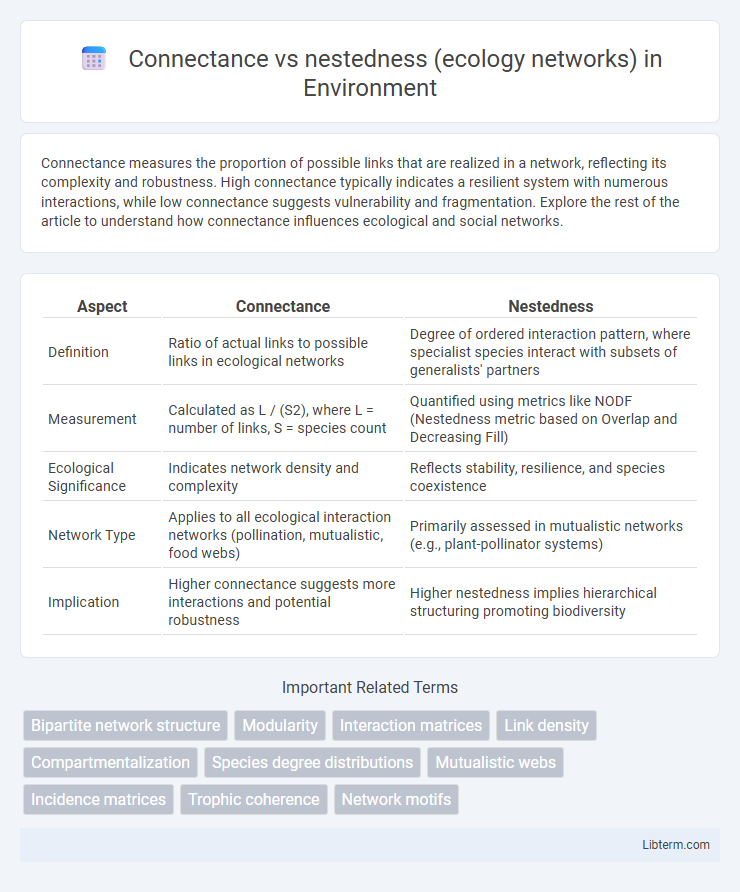Connectance measures the proportion of possible links that are realized in a network, reflecting its complexity and robustness. High connectance typically indicates a resilient system with numerous interactions, while low connectance suggests vulnerability and fragmentation. Explore the rest of the article to understand how connectance influences ecological and social networks.
Table of Comparison
| Aspect | Connectance | Nestedness |
|---|---|---|
| Definition | Ratio of actual links to possible links in ecological networks | Degree of ordered interaction pattern, where specialist species interact with subsets of generalists' partners |
| Measurement | Calculated as L / (S2), where L = number of links, S = species count | Quantified using metrics like NODF (Nestedness metric based on Overlap and Decreasing Fill) |
| Ecological Significance | Indicates network density and complexity | Reflects stability, resilience, and species coexistence |
| Network Type | Applies to all ecological interaction networks (pollination, mutualistic, food webs) | Primarily assessed in mutualistic networks (e.g., plant-pollinator systems) |
| Implication | Higher connectance suggests more interactions and potential robustness | Higher nestedness implies hierarchical structuring promoting biodiversity |
Introduction to Ecological Networks
Ecological networks represent the complex interactions among species, with connectance measuring the proportion of realized links to possible links, reflecting network complexity and robustness. Nestedness describes the ordered pattern where specialist species interact with subsets of species that generalists engage with, indicating structural organization and stability. Together, connectance and nestedness provide critical insights into ecosystem functionality and resilience by characterizing interaction patterns and network architecture.
Defining Connectance in Ecological Systems
Connectance in ecological networks quantifies the proportion of realized interactions relative to all possible interactions among species, serving as a key metric for assessing network complexity. Higher connectance indicates more interconnected communities, often linked to greater ecosystem stability and resilience. This measure contrasts with nestedness, which highlights the ordered arrangement of species interactions rather than their overall density.
Understanding Nestedness in Network Structures
Nestedness in ecological networks reflects the degree to which interactions of less-connected species form subsets of those of more-connected species, influencing community stability and biodiversity. Connectance, defined as the proportion of realized interactions out of all possible links, impacts nestedness by shaping network complexity, where higher connectance often correlates with reduced nested patterns. Analyzing nestedness alongside connectance provides critical insights into the resilience and functional organization of mutualistic and antagonistic ecosystems.
Measuring Connectance: Metrics and Approaches
Measuring connectance in ecological networks involves calculating the proportion of realized interactions relative to all possible interactions, providing a key metric for network complexity and stability. Common approaches include binary connectance, which considers presence or absence of links, and weighted connectance, incorporating interaction strengths to capture ecological nuances. Advanced metrics such as linkage density and interaction diversity further refine connectance assessment, supporting insights into network resilience and species interdependencies.
Quantifying Nestedness: Tools and Indices
Quantifying nestedness in ecological networks involves using indices such as NODF (Nestedness metric based on Overlap and Decreasing Fill) and the temperature metric, which measure the degree to which species interactions form ordered subsets. Tools like the R package bipartite provide computational methods to calculate these nestedness indices efficiently, enabling detailed analysis of mutualistic networks. Connectance, defined as the proportion of realized interactions out of all possible ones, is closely monitored alongside nestedness to interpret the structural complexity and resilience of ecological communities.
Connectance vs Nestedness: Key Differences
Connectance measures the proportion of realized interactions out of all possible connections in ecological networks, indicating network density and complexity. Nestedness quantifies the ordered pattern of interactions, where specialist species interact with subsets of generalist partners, reflecting network stability and resilience. While connectance emphasizes overall interaction frequency, nestedness highlights hierarchical organization and species role differentiation within ecosystems.
Ecological Implications of High Connectance
High connectance in ecological networks indicates a dense web of interactions among species, enhancing community stability and resilience to perturbations by promoting multiple pathways for energy flow and resource use. This structural complexity reduces the risk of cascading extinctions, as species have alternative partners to maintain ecosystem functions even if some interactions are lost. Furthermore, high connectance often correlates with increased robustness against environmental changes, fostering biodiversity persistence and ecosystem productivity.
The Role of Nestedness in Community Stability
Nestedness in ecological networks enhances community stability by structuring species interactions so that specialist species interact with subsets of the partners of generalists, reducing competition and promoting resilience. High nestedness correlates with increased robustness against species extinctions and environmental fluctuations by maintaining functional redundancy and facilitating mutualistic cooperation. Connectance, reflecting the proportion of realized interactions, influences nestedness patterns but does not solely determine stability, as networks with similar connectance can display varying degrees of nestedness and thus different stability outcomes.
Case Studies: Connectance and Nestedness in Real Ecosystems
Case studies reveal that ecosystems with high connectance often exhibit greater resilience due to dense species interactions, while nestedness tends to stabilize networks by structuring interactions hierarchically. Research on mutualistic networks, such as pollinator-plant systems, demonstrates that nestedness minimizes competition and enhances biodiversity. Empirical data from marine food webs indicate a correlation where increased connectance supports nested network patterns, promoting ecosystem robustness against species loss.
Future Directions in Network Ecology Research
Future directions in network ecology research emphasize integrating connectance and nestedness metrics to better understand ecosystem stability and resilience. Advancements in high-throughput data collection and machine learning algorithms enable precise modeling of complex interaction networks, facilitating predictions of ecological responses to environmental changes. Emphasizing spatiotemporal dynamics and multi-layer network frameworks will enhance insights into how connectance and nestedness influence biodiversity conservation and ecosystem functioning.
Connectance Infographic

 libterm.com
libterm.com